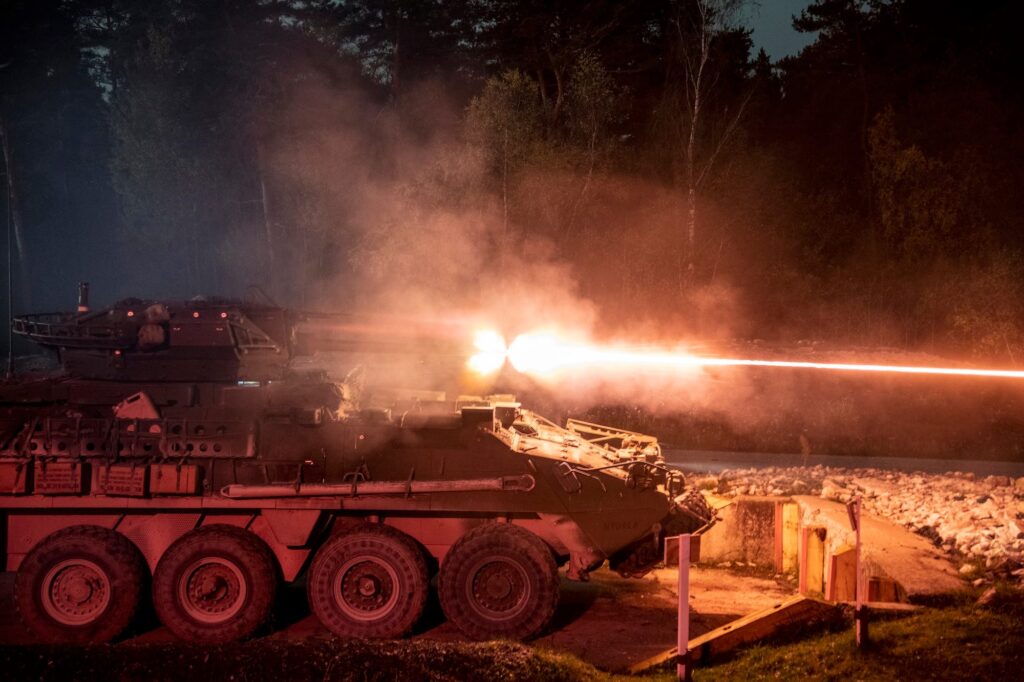- The US Army moved fast to arm its Stryker armored vehicles with a powerful autocannon.
- The 30mm gun would even the odds with Russian and Chinese troop carriers.
- But the Army put in a large order before ensuring the first turrets worked properly.
Fearing that its Stryker armored vehicles were outgunned by Russian and Chinese designs, the US Army had an idea for a quick fix: Develop an unmanned Stryker turret with a 30-mm autocannon. But cutting corners in the $1 billion project has led to hardware and software issues that mean the more lethal Strykers won't be available until at least the end of 2024, a year later than scheduled.
"In prioritizing cost savings and rapid fielding, the Army assumed additional production risks because it did not follow sound acquisition practices," according to a Government Accountability Office report.
Though Army leaders said in December 2023 that software issues had been fixed, war clouds in Europe and Asia raise the prospect that Stryker units might go into battle against Russian and Chinese armored vehicles that are more heavily armed.
Compared to ultra-complex projects such as the F-35 stealth fighter, developing a small remote-controlled turret for an armored vehicle should have been easy. The project began in 2015. Worried by growing tensions in Europe and more lethal Russian hardware, the Army's 2nd Cavalry Regiment — based in Germany — urgently requested heavier armament for the Stryker, a family of eight-wheel armored vehicles manufactured by General Dynamics Land Systems.
Instead of the Stryker's normal armament of a .50-caliber or 7.62-mm machine gun, or a 40-mm grenade launcher, troops wanted a cannon that can punch through enemy armor and hardened positions. Russia arms its BMP series of infantry fighting vehicles with 30-mm, 73-mm or 100-mm guns, while China's new heavy VN-20 troop carrier comes with 30-mm or 100-mm cannon.
The Army obliged in 2018 with the Infantry Carrier Vehicle-Dragoon, which added a remote-controlled 30-mm gun turret — manufactured by Norwegian firm Kongsberg — to 91 flat-bottom-hull versions of the Strykers. General Dynamics did the modifications under an existing contract, which allowed the Army to develop and field the upgrade in a relatively quick two years. The Army decided the next year to buy 269 unmanned 30-mm turrets, under the Medium Caliber Weapons Systems (MCWS) program, at an estimated cost of $1.1 billion. This would be enough to upgrade Strykers in three brigades of 83 vehicles each, plus an additional 20 for testing.
But instead of simply fielding more Dragoons, the Army decided to make some changes. Instead of flat-bottomed Strykers, the turrets would be mounted on the double hull A1 version that is more blast-resistant and could better bear the weight and power requirements of a gun turret. Instead of a Kongsberg MCT-30 turret, the vehicles would receive a Samson turret made by Israeli firm Rafael. And instead of General Dynamics, the prime contractor would be Oshkosh Systems, whose bid was one-third or more lower than other contenders. However, the cannon would continue to be Northrop Grumman's XM813 chain gun used on the Dragoon.
The Army also fast-tracked the project, which shouldn't have been an issue. "Army officials stated that they chose to accelerate production of the Stryker MCWS, rather than begin system development, because the effort integrated mature, proven technologies—the Stryker Double-V Hull A1 and the 30-millimeter cannon," GAO noted.
The problem was that the Army was in such a hurry that it neglected some basic precautions. For example, Oshkosh's turret "was not tested by soldiers in their intended environment during the evaluation of the samples," the report said. "Instead, the vendors acted as the commanders and gunners during testing on a range."

Nor was Oshkosh's demonstration turret built on the actual manufacturing line that would be used for full production. A big red flag should have been the glitches in the turret software that degraded the 30-mm cannon's accuracy. Because the gunner operates the cannon remotely from inside the vehicle, using a video feed rather than the naked eye, accurate targeting software is important. "The Army stated these risks were moderate because of Oshkosh Defense's assurance of a future software fix," GAO said. "Army officials acknowledged that they would not have the ability to evaluate the success of the software fix prior to awarding the production contract."
A perceived need to get improved vehicles to troops in the field is understandable. But what was unusual was that the Army "put in delivery orders for all 269 vehicles before ensuring that production line issues were addressed," Mona Sehgal, acting director of GAO's contracting and national security acquisitions team, told Business Insider.
The Army awarded Oshkosh the first order in June 2021 for 91 MCWS, followed by a second order for 83 in July 2021 and finally 95 in June 2022, according to GAO. The first turrets weren't actually delivered until July 2022.
Normal practice — in the Department of Defense or the business world — would be to place an initial order to judge the quality of the product, before placing further orders. "The Army had structured the agreement to allow that but chose not to execute it that way," Sehgal said.
Michael Peck is a defense writer whose work has appeared in Forbes, Defense News, Foreign Policy magazine, and other publications. He holds an MA in political science from Rutgers Univ. Follow him on Twitter and LinkedIn.










